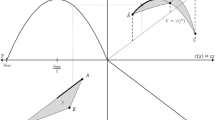Abstract
Technical and scale efficiencies of Data Envelope Analysis are associated with a two dimensionalsection (a convex set) representing the amounts by which the input and output vectors of a reference decision making unit, may be scaled and still lie in the production possibility set. We describe a simple algorithm, closely resembling the simplex algorithm of linear programming, to traverse the boundary of this set. Given the output of our algorithm, the scalar efficiency measures and return-to-scale characterization are trivially determined. Moreover, the set may be graphically displayed for any problem in any number of dimensions with only a minimum of additional computing effort.
Similar content being viewed by others
References
Banker, R.D. (1984). “Estimating Most Productive Scale Size Using Data Envelope Analysis,”European Journal of Operations Research, 17, 35–44.
Banker, R.D., A. Charnes, and W.W. Cooper (1984). “Some Models for Estimating Technical and Scale Inefficiencies in Data Envelopment Analysis.”Management Science, 30., 1078–1092.
Banker, R.D., Thrall, R.M. (1992). “Estimation of Returns to Scale Using Data Envelopment Analysis.”European Journal of Operational Research, 62, 74–84.
E.R. Barnes, A.J. Hoffman and Uriel G. Rothblum. (1992). “Optimal Partitions having Disjoint Convex and Conic Hulls.”Mathematical Programming, 54, 69–86.
Byrnes, P., R. Fare and S. Grosskopf. (1984). “Measuring Productive Efficiency: an Application to Illinois Strip Mines.”Management Science, 30, 671–680.
Charnes, A. (1952). “Optimality and Degeneracy in Linear Programming.”Econometrica 20, 160–170.
Charnes, A., W.W. Cooper and E. Rhodes. (1978). “Measuring the Efficiency of Decision Making Units.”European Journal of Operations Research 2, 429–444.
Charnes, A., W.W. Cooper, and R.M. Thrall. (1986). “Classifying and Characterizing Efficiencies and Inefficiencies in Data Envelopment Analysis”.Operations Research Letters., 105–110.
Charnes, A., W.W. Cooper, and R.M. Thrall. (1991). “A Structure of Characterizing and Classifying Efficiencies and Inefficiencies in Data Envelopment Analysis,”The Journal of Productivity Analysis, 2, 197–237.
Charnes, A., W.W. Cooper, Q.L. Wei, and Z.M. Huang. (1987). “Cone Ratio Data Envelope Analysis and Multi-Objective Programming.” Research Report CCS559, Center for Cybernetic Studies, The University of Texas at Austin.
Thompson, R.G., F.D. Singleton, R.M. Thrall and B.A. Smith. (1986). “Comparative Site Evaluations for Locating a High-Energy Lab in Texas,”Interfaces, 16, 35–49.
Author information
Authors and Affiliations
Rights and permissions
About this article
Cite this article
Hackman, S.T., Passy, U. & Platzman, L.K. Explicit representation of the two-dimensional section of a production possibility set. J Prod Anal 5, 161–170 (1994). https://doi.org/10.1007/BF01073852
Issue Date:
DOI: https://doi.org/10.1007/BF01073852




